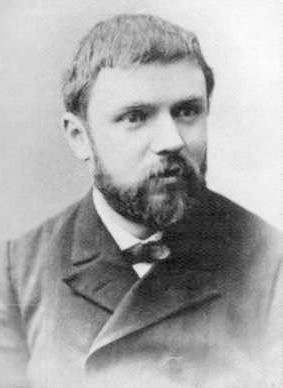| Henri Poincaré as a young man (Photo from Wikipedia) |
In 1885, King Oscar II of Sweden
and Norway
offered a prize to whoever could solve one of the most
important mathematical issues of the day. The King’s problem was expressed in this way:
“Given a system of arbitrarily many mass points that attract
each other according to Newton 's
laws, under the assumption that no two points ever collide, try to find a
representation of the coordinates of each point as a series in a variable that
is some known function of time and for all of whose values the series converges
uniformly.”
In relation to our solar system, the problem is whether it is possible to establish whether it can continue indefinitely as it
now exists, or whether it is possible that at some point in the future the
Earth and other planets will spin away from their current orbits, or even collide.
Henri Poincaré believed the universe was governed by predictable
laws, adopting an approach similar to Newton ,
two hundred years before him. He thought he had the mathematical skills to take
on this challenge. He began by modelling 2 planets, then added a third. At this
point, the model becomes very complicated, and although he could not find a
full solution, Poincaré’s paper was considered worthy of the prize.
When the paper had been delivered and was ready for publication, a serious error was discovered
in Poincaré’s working. He attempted to withdraw the paper, but was told that
his letter had arrived too late, the paper had already been printed. The prize that was going to be awarded would now be withdrawn. To add to his humiliation, Poincaré was asked to pay for the printing,
which was more than his original prize money.
He attempted to understand his own mistake and noticed that
the problem stemmed from an approximation to an object’s position. This led him
to realise that any such approximation is invalid – the initial starting conditions
of his objects could produce large differences in their positions later on in
the system’s evolution. He wrote a second paper explaining this idea.
Thus, it appears there are certain problems for which mathematical
modelling cannot predict a solution, since initial conditions can never be
precisely measured. Today we know this phenomenon as the Butterfly Effect or
Chaos Theory. A well-known example is in weather forecasting: although the Met
Office gathers millions of pieces of data each day from right across the globe,
it is impossible for these data to be perfectly accurate. The weather is a
chaotic process, and these uncertainties over initial data can lead to large
differences in the weather patterns a few days later.
To compensate for this, the Met Office run an “ensemble
prediction” – the same model several times with slightly different starting
conditions. Many forecasts are produced, sometimes very similar, other times very
different and this leads to uncertainty in the forecast.
Other chaotic processes include the beat of the human heart,
population of insects, rabbits and other animals and, as we have seen,
undetectable differences in the orbits of the celestial bodies, e.g. asteroids,
can later result in completely different patterns within our solar system, even
a collision with Earth.
With these new, early insights, a new field of mathematical
study was born and Poincaré was established as one of the main players in French mathematics.
Poincaré is remembered for far more than just Chaos Theory. He excelled in all branches of mathematics and formulated the Poincaré conjecture. This conjecture about spheres in four-dimensional space remained unproven for almost 100 years. It had defeated so many brilliant mathematicians that it was included in the seven Millennium Prize Problems, for which the Clay Mathematics Institute offered a $1,000,000 prize for the first correct solution. In 2002 and 2003, the Russian mathematician Grigori Perelman cracked it, then famously rejected the prize and any honours for doing so.
So Poincaré rightly takes his place in an exclusive group of mathematicians who have changed the face of the subject. Not only that, he did it in several different ways. We should remember Henri Poincaré, who died 100 years ago today, as one of the giants of modern mathematics.

No comments:
Post a Comment
Note: only a member of this blog may post a comment.